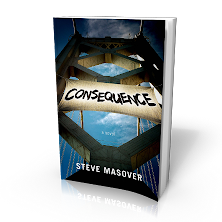Up front confession: I feel a connection to Haring's work because he depicted a zeitgeist that defined times (early 80s) and places (New York and San Francisco) that mean a lot to me personally. Haring was drawing all over New York's subway stations as I edged out of the closet in 1982, in the SF Bay Area. The AIDS epidemic that took his life at age 31, in 1990, was killing thousands of gay men in his community and mine -- this during a period when the U.S. government callously abdicated its role in public health and precipitated the emergence of a movement that wholly upended the relationship between patients and medical authority.
That connection aside, the signature value of the show at the de Young is the clear view it affords of how Haring took a small set of archetypal forms (simply drawn humans, dogs, flying saucers, televisions, crude/sharp weapons, et al.) and combined them vividly, energetically, and in rich combinations and juxtapositions to create a lively and evocative body of work. As I walked through the exhibit several times, back and forth, it occurred to me that complaints about his 'limited' set of tropes bear a certain resemblance to fretting over the fact that the whole of European and American literature is composed of a mere 26 repeating letters of the Roman alphabet. That is, it kind of misses the point. Forest for trees and all that. Haring's work isn't about the individual elements of his work: it's about how they work in concert.
Among my first jolts of the exhibit was a look at this painting created in 1981:
Twenty-three years ahead of the event, Haring nailed the feel of images that flooded out of Abu Ghraib prison in 2004, and prefigured the Columbian artist Fernando Botero's paintings that interpreted them.
Then there were the hell-on-Earth paintings that evoked the work of Hieronymus Bosch, painted in the 15th and 16th centuries --
-- like these:
But Haring's work (and the show at the de Young) wasn't all about power, politics, or reference to art that came before and after Haring's too-brief time on culture's stage. There is something philosophically fascinating (to me at least) about how the crowded, chaotic interplay between his simple lines and figures suggest interpenetration and interconnection of, well, everything. This piece from the early 80s -- though it does, on its surface, depict elaborately constructed, otherworldly, omnipotent power, and human fear and helplessness before it -- themes Haring treats throughout his oeuvre -- also evokes a world in which the borders between everything and everyone are as flimsy and vulnerable as life itself, all in the seemingly random scribbles inside and outside the fleeing human figures.
Powerful stuff. Check it out if you can.
Thanks to Wikimedia Commons for the image of a bound prisoner being terrorized by an American soldier and his dog at Abu Ghraib prison in Iraq, first published by the Washington Post in May 2004; and for the right panel of Hieronymus Bosch's ~15th century tryptich, the Garden of Earthly Delights.
Related posts on One Finger Typing:
Acting up, fighting back: AIDS activism in the '80s and '90s
Transit
Everything relates to everything else



.JPG)















